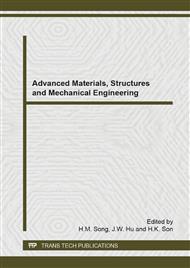p.703
p.709
p.717
p.723
p.731
p.737
p.745
p.749
p.755
Diffusion Coefficient of Nickel in Ni2Al3 Intermetallic Compound
Abstract:
Nickel alloys have been widely used for high temperature applications such as gas turbine engine, turbine blade and many high temperature resistance components. Aluminizing is one of effective to increase oxidation resistant of nickel alloys by forming nickel aluminide compounds on nickel surface. Nickel aluminide is formed by the diffusion mechanism. This research aims to study the diffusion behavior of nickel in Ni2Al3 compound. The diffusion coefficient is determined using Ni/Al diffusion couple forming Ni2Al3 and NiAl3 phases. The temperatures under study are 873, 973, and 1073 K, which are at above and below melting point of aluminum. Determination of diffusion coefficient of Ni in Ni2Al3 is from mass balance concept: flux difference at interphase causes accumulation of atoms in compound layer, which as be derived as: dxαβ/dt = [1/(nβ-nα)] * [Dα *(dnα/dx) - Dβ *(dnβ/dx)] From this equation, diffusion coefficient of Ni in Ni2Al3 at 873 and 1073 K are calculated as 6.243×10-11 and 6.82×10-9 m2/s, respectively. From Arrhenius equation of diffusivity, D = Doexp (-Q/RT), the activation energy for diffusion of nickel in Ni2Al3 is found to be 183 kJ/mol. The result obtained in this research is of great use in controlling aluminizing process.
Info:
Periodical:
Pages:
731-736
Citation:
Online since:
September 2014
Keywords:
Price:
Сopyright:
© 2014 Trans Tech Publications Ltd. All Rights Reserved
Share:
Citation:


